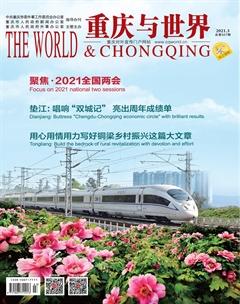安达森洋行旧址 战火中曾存放故宫国宝
杨艳 杨滨瑞



在开埠时期和抗战时期,重庆迎来近代对外开放的两个历史高潮,重庆与外国在政治、经济、军事、外交、文化等领域活動中交流、互动、合作,形成了大量具有重要历史意义和价值的代表性建筑,主要包括洋行、外事机构、名人旧居等。
1891年3月1日,重庆海关建立,标志着重庆正式开埠。此后,西方商人开始在重庆建立洋行和贸易公司,沿江做买卖。位于南岸区海狮路2号的安达森洋行就建造于那个时期,为重庆开埠时期代表性建筑。其主人安达森是一位瑞典商人,主要经营中国的土特产进出口贸易。依山而建的安达森洋行旧址,面朝长江,与渝中半岛隔江而望,与慈云寺一墙之隔。
安达森洋行曾作为瑞典贸易公司的办公场所和仓库,包含8栋建筑,占地面积约10000平方米,建筑面积约2700平方米,是具有仓储式特点的洋行建筑群。一坡长长的石梯将仓库连为一体,形如堡垒。各仓库均采用人字坡小青瓦屋面,大梁穿斗结构,筑土为墙、石质基座。在部分建筑屋顶增加了开窗,以增强仓库的通风与采光。2019年2月,安达森洋行旧址被列为市级重点文物保护单位。
但和其他老城建筑不一样的是,该建筑虽是一座普通洋楼,没有精致的雕梁画栋,而它与众不同之处则在于一段特殊的往事。
1933年1月31日山海关失陷后,故宫博物院理事会决定将故宫部分文物分批运出北平(北京旧称),2月6日夜,当夜北平全城戒严,故宫博物院第一批南迁文物从午门出发,人类历史上一次最大规模的文物大迁徙—故宫文物南迁正式拉开序幕。
1938年5月,在故宫文物南迁过程中,9000多箱故宫文物几经辗转从汉口运往重庆,分三处地址存放,其中一处便是重庆南岸安达森洋行的4个仓库,共在此存放文物3694箱。
1939年4月,日军飞机反复轰炸重庆,每当天空出现飞机,洋行老板安达森就会安排将瑞典国旗挂上房顶旗杆以求安全,最终安达森洋行幸免被炸,藏于此洋行的故宫文物因此完好无损。1946年1月至1947年3月,存放于巴县、乐山、峨眉的三路文物陆续集中到重庆南岸。1947年5月至12月,全部南迁文物从南岸海棠溪码头运返南京。
故宫博物院研究馆员冯贺军表示,选择安达森洋行仓库,除了因为其面积大、空间高,有便利的水运交通外,更重要的是因为这里的建造者安达森是瑞典人。瑞典在第二次世界大战中是中立国,安达森洋行仓库被视为中立国的商民资产,不易遭到日军轰炸。
安达森洋行旧址见证了故宫文物南迁史,基于这样的历史沿革,以“故宫文物南迁”为历史文脉,保护故宫文物南迁旧址为使命,故宫文物南迁纪念馆今天得以落户重庆市南岸区南滨路安达森洋行旧址。2016年,建筑受损严重的安达森洋行旧址开始启动修缮与改造工程,大部分仍保留原有的结构特征。根据建筑风貌延续和更新,历史遗存在现代技术的加持下,安达森洋行旧址重现百年荣光,现已赋予新的功能与使命,面向公众开放。正在此处展出的“近代开放视野下的重庆”历史遗址图片展览,是对重庆近代开埠和抗战时期对外开放历史的回望。
据了解,故宫文物南迁纪念馆内8栋建筑分别容纳了数字故宫、故宫课堂、故宫出版社书吧、故宫文物南迁纪念馆、故宫文创、角楼咖啡等文化业态,结合独特的巴渝风貌与山水景观,这里成为值得一游的人文胜景。
During the port opening period and the War of Resistance Against Japanese Aggression, Chongqing ushered in two historical upsurges of modern opening up. With the exchanges, interaction, and cooperation in political, economic, military, diplomatic, cultural and other fields between Chongqing and foreign countries, a myriad of representative buildings with historical significance and value, mainly foreign firms, foreign affairs institutions, celebrities' former residences, etc, were formed.
On March 1, 1891, the establishment of Chongqing Customs marked the official opening of Chongqing as a port. Since then, Western businessmen began to set up foreign firms and trading companies in Chongqing to do business along the river. Anderson & Co., located at No.2 Haishi Road, Nan'an District, was built at that time as a representative building of Chongqing during the port-opening period. Its owner Anderson, a Swedish businessman, was mainly engaged in the import and export trade of Chinese local specialties. Built along the mountains, the former site of Anderson & Co., faces Yuzhong Peninsula across the Yangtze River and neighbors Ciyun Temple.
Once offices and warehouses of a Swedish trading house, Anderson & Co. is a typical foreign firm building complex with warehousing characteristics. With eight buildings, it covers an area of about 100,000 square meters and a floor area of about 2,700 square meters. A long stone ladder connects into the warehouse like a fortress. All warehouses adopt herringbone slope small grey tile roof with Chuan-dou-styled beam, earth wall and stone foundation. Windows were added to the roofs of some buildings to enhance the ventilation and lighting of the warehouses. In February 2019, the former site of Anderson & Co. was designated as a municipal-level core historic preservation unit.
Unlike other old city buildings, this building, though an ordinary Western style building without exquisite carved beams and painted buildings, differentiates itself with a special past.
After the fall of Shanhaiguan on January 31, 1933, the Council of Palace Museum decided to ship some cultural relics out of Beiping City in batches. On the night of February 6, Beiping City was imposed a curfew. The first batch of Palace Museum's south-moving cultural relics left from the Meridian Gate as the largest cultural relics relocation in human history.
In May 1938, in the process of southward relocation of cultural relics, over 9,000 boxes of cultural relics of the Forbidden City were secretly transported from Hankou to Chongqing and stored in three places. One of the secret hideouts consisted of four warehouses, properties of the Anderson & Co., stored 3,694 boxes of artifacts.
In April 1939, when Japanese aircraft bombed Chongqing repeatedly, every time an enemy plane appeared in the sky, Anderson, the owner of the foreign firm, would raise the Swedish flag for safety. Fortunately, Anderson & Co. survived the bombing, so did treasures preserved there. From January 1946 to March 1947, cultural relics previously stored in Ba County, Leshan and Emei, were successively centralized in the Nan'an District of Chongqing. From May to December 1947, all the cultural relics moving to the south were shipped back to Nanjing from Haitangxi Wharf in Nan'an District of Chongqing.
Feng Hejun, a research librarian of the Palace Museum said that in addition to its large area, elevated space and convenient water transportation, the reason for choosing Anderson & Co.'s warehouses is that Anderson, the owner, was a Swede. Sweden was a neutral country amid the Second World War. Anderson & Co.'s warehouses were therefore deemed as the commercial and civilian assets of the neutral country and thus immune from the bombing of the Japanese army.
The former site of Anderson & Co. witnessed the history of the southward relocation of the cultural relics of the Forbidden City. Based on this historical evolution, taking "the southward relocation of the cultural relics of the Forbidden City" as the historical context and protecting the former site of the southward relocation of the cultural relics of the Forbidden City as the mission, Southward Relocation of Forbidden City s Artifacts Memorial and Forbidden City Gallery (Chongqing) was seated in the former site of Anderson & Co., Nanbin Road, Nan'an District, Chongqing. In 2016, the repair and adaptation project of the former site of Anderson & Co. started. Most of the original structural features were still preserved. According to the continuation and renewal of the architectural style, relying on cutting-edge technologies, the former site of Anderson & Co. regained its centennial splendor. Having been given new functions and missions, now it is open to the public. The historic relic photo exhibition of "Chongqing in the view of modern opening-up" on display here offers a retrospect of Chongqing's port opening in modern times and during the War of Resistance Against Japanese Aggregation.
It is reported that eight buildings in the Southward Relocation of Forbidden City s Artifacts Memorial and Forbidden City Gallery (Chongqing) respectively incorporate the corner tower coffee, the digital Forbidden City, the Forbidden City classroom, the book bar of the Forbidden City Press, the memorial hall of cultural relics southward relocation of the Forbidden City, the cultural creativity of the Forbidden City and other cultural forms. Combined with the unique Bayu style and landscape, it can be called a cultural attraction worth visiting.

